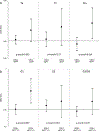Diesel exhaust and bladder cancer risk by pathologic stage and grade subtypes
- PMID: 31864026
- PMCID: PMC8237313
- DOI: 10.1016/j.envint.2019.105346
Diesel exhaust and bladder cancer risk by pathologic stage and grade subtypes
Abstract
Background: The International Agency for Research on Cancer (IARC) classifies diesel engine exhaust as carcinogenic to humans based on sufficient evidence for lung cancer. IARC noted, however, an increased risk of bladder cancer (based on limited evidence).
Objective: To evaluate the association between quantitative, lifetime occupational diesel exhaust exposure and risk of urothelial cell carcinoma of the bladder (UBC) overall and according to pathological subtypes.
Methods: Data from personal interviews with 1944 UBC cases, as well as formalin-fixed paraffin-embedded tumor tissue blocks, and 2135 controls were pooled from two case-control studies conducted in the U.S. and Spain. Lifetime occupational histories combined with exposure-oriented questions were used to estimate cumulative exposure to respirable elemental carbon (REC), a primary surrogate for diesel exhaust. Unconditional logistic regression and two-stage polytomous logistic regression were used to calculate odds ratios (ORs) and 95% confidence intervals (CIs), adjusting for smoking and other risk factors.
Results: Exposure to cumulative REC was associated with an increased risk of UBC; workers with cumulative REC >396 μg/m3-years had an OR of 1.61 (95% CI, 1.08-2.40). At this level of cumulative exposure, similar results were observed in the U.S. and Spain, OR = 1.75 (95% CI, 0.97-3.15) and OR = 1.54 (95% CI, 0.89-2.68), respectively. In lagged analysis, we also observed a consistent increased risk among workers with cumulative REC >396 μg/m3-years (range of ORs = 1.52-1.93) for all lag intervals evaluated (5-40 years). When we accounted for tumor subtypes defined by stage and grade, a significant association between diesel exhaust exposure and UBC was apparent (global test for association p = 0.0019).
Conclusions: Combining data from two large epidemiologic studies, our results provide further evidence that diesel exhaust exposure increases the risk of UBC.
Keywords: Bladder cancer; Diesel exhaust; Occupation.
Published by Elsevier Ltd.
Conflict of interest statement
Declaration of Competing Interest
The authors declare no competing financial interests.
Figures

References
-
- Amaral AF, Mendez-Pertuz M, Munoz A, Silverman DT, Allory Y, Kogevinas M, Lloreta J, Rothman N, Carrato A, Rivas del Fresno M, Real FX, Malats N, et al., 2012. Plasma 25-hydroxyvitamin D(3) and bladder cancer risk according to tumor stage and FGFR3 status: a mechanism-based epidemiological study. J. Natl. Cancer Inst 104, 1897–1904. - PMC - PubMed
-
- Benbrahim-Tallaa L, Baan RA, Grosse Y, Lauby-Secretan B, El Ghissassi F, Bouvard V, Guha N, Loomis D, Straif K, 2012. International Agency for Research on Cancer Monograph Working G. Carcinogenicity of diesel-engine and gasoline-engine exhausts and some nitroarenes. Lancet Oncol. 13, 663–664. - PubMed
-
- Birch ME, Cary RA, 1996. Elemental carbon-based method for occupational monitoring of particulate diesel exhaust: methodology and exposure issues. Analyst 121, 1183–1190. - PubMed
-
- Boffetta P, Silverman DT, 2001. A meta-analysis of bladder cancer and diesel exhaust exposure. Epidemiology 12, 125–130. - PubMed
Publication types
MeSH terms
Substances
Grants and funding
LinkOut - more resources
Full Text Sources
Medical

